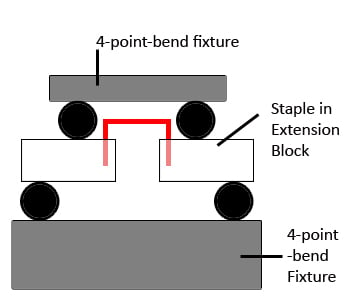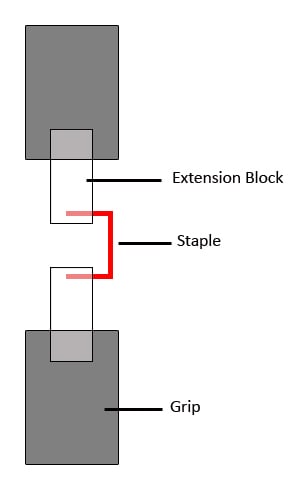ASTM F564 details three types of tests commonly conducted during the product development process of metallic staples to be used in medical applications related to bone. This post is intended to help you understand the basic procedures and the equipment needed to complete the fatigue, pull-out strength, fixation strength, and bending tests explained in the specification. For complete instructions, please refer to ASTM F564.
Test 1 – Bending Fatigue Tests of Metallic Bone Stapes
Procedure:
- Fix and align each staple leg into the extension block using the specified filling agent.

- Place the staple and extensions into a 4-point-bend fixture.

- Begin to apply cyclic loads to create a non-permanent bend in the staple.
- Continue test until specimen failure.
- Place another staple and extensions into an axial (tension/compression) fixture.
- Begin to apply cyclic loads to create a non-permanent bend in the staple.
- Continue test until specimen failure.
Analysis:
- Min/Max cycle loads.
- Bending moment using the formula given in the specification.
- Number of cycles at failure and location of fracture.
Equipment Recommended:
- A testing frame capable of applying the required cyclic loads.
- A testing controller capable of cyclic fatigue testing.
- A pair of metal staple extensions as described in the specification.
- A 4 point bend fixture.
- A standard fixture to apply tensile or compressive force.
ADMET offers electromechanical and hydraulic fatigue testing frames in single and dual configurations. MTESTQuattro, an advanced PC-Based testing machine controller with advanced analysis and reporting capabilities is recommended for fatigue tests. We offer a full line of bend fixtures and have the capability to custom design a fixture or extension to securely hold your specimen.
Test 2 – Pull-Out Fixation Strength of Metallic bone Staples
Procedure:
- Fix a thin and flat metal or fabric strap onto a piece of bone or bone substitute using a staple. Make sure to insert the staple following the correct surgical/manufacturer indicated processes. The staple should not penetrate the strap but rather act as a loop to hold the bone sample to the strap.
- Fix the bone sample into one bottom machine grip. Connect the ends of the strap and fix them into the other machine grip.
- Begin to the sample at a constant rate.
- Stop the test at visible tearing or rupture of the strap, fracture of the bone, or loosening of the staple.
Analysis:
- Load at staple pull-out or failure
Equipment Recommended:
- A testing machine frame capable of applying the tensile force needed to test your specimen
- A testing controller capable of reporting peak load at failure
- Metal or fabric straps as described in the specification
- A pair of vise grips to hold the strap ends and bone sample
ADMET offers electromechanical and hydraulic tensile testing frames in single and dual column configurations. Both the eP2 Digital Controller and MTESTQuattro PC-Based controller are capable of applying tensile force at a constant rate and reporting peak load. We offer a full line of grips and have the capability to custom design a fixture or extension to securely hold your specimen.
Test 3 – Soft Tissue Fixation Strength of Metallic Bone staples
Procedure:
- Secure a piece of soft tissue or tissue substitute onto a piece of bone or bone substitute using one or multiple staples. Make sure to insert the staple following the correct surgical/manufacturer indicated processes.
- Fix the bone sample into one bottom machine grip. Secure the tissue sample on the other machine grip.
- Begin pulling the sample at a constant rate.
- Stop the test at visible tearing or rupture of the strap, fracture of the bone, or loosening of the staple.
Analysis:
- Load at staple failure.
Equipment Recommended:
- A testing machine frame capable of applying the tensile force needed to test your specimen
- A testing controller capable of reporting peak load at failure
- Tissue and bone samples to secure the staple.
- A pair of grips designed to securely hold bone and tissue samples without damaging them.
ADMET offers electromechanical and hydraulic tensile testing frames in single and dual configurations. Both the eP2 Digital Controller and MTESTQuattro PC-Based controller are capable of applying tensile force at a constant rate and reporting peak load. We offer a full line of grips and have the capability to custom design a fixture or extension to securely hold your specimen.
Test 4 – Static Bending of Metallic Bone Staples
Procedure:

- Before testing the staple, measure the deflection under testing load of the bend fixtures and gripping devices as described in the specification. You might have to adjust your results depending on how much these devices bend.
- Fix and align each staple leg into the extension block using the specified filling agent.
- Place the extension blocks onto the bottom of the 4-point-bend-fixture.
- Apply downward force onto the extension blocks with the top of the 4-point-bend fixture at the constant rate specified.
- Continuously graph load versus displacement.
- Continue the test until enough data is gathered to accurately assess the stiffness of the sample.
Analysis:
- Load vs displacement graph (bending curve). Graph on left generated using MTESTQuattro.
- Mean and standard deviation of the slope.
Equipment Recommended:
- A testing machine frame capable of applying the required downward force.
- A testing controller capable of moving the actuator at a constant rate, recording load vs displacement, and displaying those results graphically.
- A pair of metal staple extensions as described in the specification.
- A 4 point bend fixture.
ADMET offers electromechanical and hydraulic bend testing frames in single and dual configurations. Both the eP2 Digital Controller and MTESTQuattro PC-Based controller are capable of applying tensile force at a constant rate and reporting peak load. We offer a full line of bend fixtures and have the capability to custom design a fixture or extension to securely hold your specimen.











